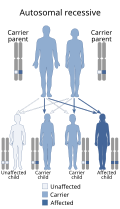Aminoacylase 1 deficiency
| Aminoacylase 1 deficiency | |
|---|---|
| Synonyms | N/A |
| Pronounce | N/A |
| Specialty | N/A |
| Symptoms | Developmental delay, Intellectual disability, Seizures |
| Complications | N/A |
| Onset | Infancy |
| Duration | Lifelong |
| Types | N/A |
| Causes | Genetic mutation in the ACY1 gene |
| Risks | N/A |
| Diagnosis | Genetic testing |
| Differential diagnosis | N/A |
| Prevention | N/A |
| Treatment | Supportive care |
| Medication | N/A |
| Prognosis | N/A |
| Frequency | Rare |
| Deaths | N/A |
Aminoacylase 1 deficiency is a rare metabolic disorder caused by mutations in the ACY1 gene. This condition is characterized by a range of symptoms including developmental delay, intellectual disability, and seizures.
Genetics[edit]
Aminoacylase 1 deficiency is inherited in an autosomal recessive pattern, meaning that an individual must inherit two copies of the mutated gene, one from each parent, to be affected. The ACY1 gene provides instructions for making an enzyme called aminoacylase 1, which is involved in the breakdown of N-acetylated amino acids.
Symptoms[edit]
The symptoms of aminoacylase 1 deficiency can vary but often include:
- Developmental delay
- Intellectual disability
- Seizures
- Hypotonia (reduced muscle tone)
- Ataxia (lack of voluntary coordination of muscle movements)
Diagnosis[edit]
Diagnosis of aminoacylase 1 deficiency is typically confirmed through genetic testing that identifies mutations in the ACY1 gene. Additional tests may include metabolic screening and neuroimaging to assess the extent of neurological involvement.
Treatment[edit]
There is currently no cure for aminoacylase 1 deficiency. Treatment is focused on managing symptoms and may include:
- Anticonvulsant medications to control seizures
- Physical therapy to improve motor skills
- Occupational therapy to assist with daily activities
- Speech therapy to address communication difficulties
Prognosis[edit]
The prognosis for individuals with aminoacylase 1 deficiency varies depending on the severity of symptoms. Early intervention and supportive therapies can improve quality of life.
Research[edit]
Ongoing research is focused on understanding the molecular mechanisms of aminoacylase 1 deficiency and developing potential therapies.
See also[edit]
References[edit]
<references/>
External links[edit]
- [Genetic and Rare Diseases Information Center (GARD) - Aminoacylase 1 deficiency](https://rarediseases.info.nih.gov/diseases/10700/aminoacylase-1-deficiency)
| Metabolic disorders | ||||||||||
|---|---|---|---|---|---|---|---|---|---|---|
This metabolic disorder related article is a stub.
|
-
Autosomal recessive inheritance pattern
Ad. Transform your life with W8MD's Budget GLP-1 injections from $75


W8MD offers a medical weight loss program to lose weight in Philadelphia. Our physician-supervised medical weight loss provides:
- Weight loss injections in NYC (generic and brand names):
- Zepbound / Mounjaro, Wegovy / Ozempic, Saxenda
- Most insurances accepted or discounted self-pay rates. We will obtain insurance prior authorizations if needed.
- Generic GLP1 weight loss injections from $75 for the starting dose.
- Also offer prescription weight loss medications including Phentermine, Qsymia, Diethylpropion, Contrave etc.
NYC weight loss doctor appointmentsNYC weight loss doctor appointments
Start your NYC weight loss journey today at our NYC medical weight loss and Philadelphia medical weight loss clinics.
- Call 718-946-5500 to lose weight in NYC or for medical weight loss in Philadelphia 215-676-2334.
- Tags:NYC medical weight loss, Philadelphia lose weight Zepbound NYC, Budget GLP1 weight loss injections, Wegovy Philadelphia, Wegovy NYC, Philadelphia medical weight loss, Brookly weight loss and Wegovy NYC
|
WikiMD's Wellness Encyclopedia |
| Let Food Be Thy Medicine Medicine Thy Food - Hippocrates |
Medical Disclaimer: WikiMD is not a substitute for professional medical advice. The information on WikiMD is provided as an information resource only, may be incorrect, outdated or misleading, and is not to be used or relied on for any diagnostic or treatment purposes. Please consult your health care provider before making any healthcare decisions or for guidance about a specific medical condition. WikiMD expressly disclaims responsibility, and shall have no liability, for any damages, loss, injury, or liability whatsoever suffered as a result of your reliance on the information contained in this site. By visiting this site you agree to the foregoing terms and conditions, which may from time to time be changed or supplemented by WikiMD. If you do not agree to the foregoing terms and conditions, you should not enter or use this site. See full disclaimer.
Credits:Most images are courtesy of Wikimedia commons, and templates, categories Wikipedia, licensed under CC BY SA or similar.
Translate this page: - East Asian
中文,
日本,
한국어,
South Asian
हिन्दी,
தமிழ்,
తెలుగు,
Urdu,
ಕನ್ನಡ,
Southeast Asian
Indonesian,
Vietnamese,
Thai,
မြန်မာဘာသာ,
বাংলা
European
español,
Deutsch,
français,
Greek,
português do Brasil,
polski,
română,
русский,
Nederlands,
norsk,
svenska,
suomi,
Italian
Middle Eastern & African
عربى,
Turkish,
Persian,
Hebrew,
Afrikaans,
isiZulu,
Kiswahili,
Other
Bulgarian,
Hungarian,
Czech,
Swedish,
മലയാളം,
मराठी,
ਪੰਜਾਬੀ,
ગુજરાતી,
Portuguese,
Ukrainian
